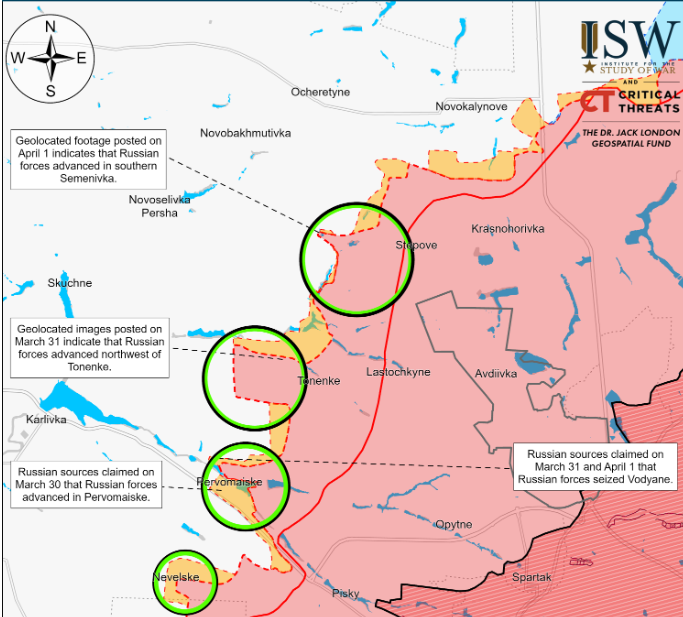ISW: Russia increases number and size of mechanized ground assaults over past 2 weeks
According to ISW, reasons of Russian intensified assaults may include: muddy spring conditions may make maneuver harder later; taking advantage before Western aid arrives

The Institute for the Study of War (ISW) reported on 3 April that Russian forces increased the number and size of mechanized ground assaults on select sectors of the frontline in Ukraine within the past two weeks.
According to ISW, earlier reports citing Ukrainian officials stated that “on 20 March, Ukrainian forces repelled a large Russian assault in the Lyman direction and published geolocated footage showing Ukrainian forces damaging or destroying several Russian armored vehicles east of Terny in Donetsk Oblast.”
The report further noted that “Ukrainian forces later defeated a battalion-sized Russian mechanized assault near Tonenke (west of Avdiivka) on 30 March, to which Russian forces reportedly committed at least 36 tanks and 12 BMP infantry fighting vehicles (IFVs).”
ISW reported that “Russian forces have likely only conducted one other mechanized assault of that scale along the entire frontline since the beginning of the Russian campaign to seize Avdiivka in October 2023, which was also near Terny on 20 January.” Additionally, “geolocated footage published on 3 April shows Ukrainian forces repelling a roughly reinforced platoon-sized mechanized Russian assault near Terny.”
The ISW’s report suggests two possible reasons for the increased mechanized assaults. First, “Russian forces may intensify mechanized assaults before muddy terrain becomes more pronounced in the spring and makes mechanized maneuver warfare more difficult.” Second, “Russian forces may also be intensifying mechanized assaults to take advantage of Ukrainian materiel shortages before the arrival of expected Western security
ISW also reported that the intensification of Russian mechanized assaults has occurred generally at the same time as intensified strikes against Ukrainian energy and electricity infrastructure.
The strikes may be aimed at pressuring the Ukrainian command to deploy air defense systems away from the front to more safely intensify aviation operations in support of ground operations, according to ISW.
Ukrainian military observer Kostyantyn Mashovets reported that “Russian forces have been gradually moving materiel and personnel to frontline positions in small increments, making it difficult for Ukrainian forces to monitor Russian force accumulations.” This suggests that Russian forces have been preparing for larger-scale assault operations.
US Deputy Secretary of State Kurt Campbell said on 3 April that the US assesses Russia has “almost completely reconstituted militarily” over the past several months. This implies that “Russia is preparing and may already have sufficient manpower and materiel to significantly intensify ongoing offensive operations or initiate offensive efforts in new areas of the theater.”
Other takeaways from the report:
- Ukrainian sources continue to stress that the piecemeal and delayed arrival of new Western systems to Ukraine will allow Russian forces to adapt to and offset the likely operational benefits these systems would otherwise provide to Ukrainian forces.
- The Russian Ministry of Defense (MoD) claimed that the 22 March Crocus City Hall attack had caused a significant increase in Russian contract service applicants amid reported Russian efforts to increase force generation this spring.
- Republic of Tatarstan Head Rustam Minnikhanov warned that Russian companies and local authorities must defend themselves against Ukrainian drone strikes and not rely on Russian air defenses following the 2 April Ukrainian strikes on Russian military production and oil refinery infrastructure in Tatarstan.
- Ukraine and Finland signed a 10-year bilateral security agreement on 3 April.
- Russian forces recently made confirmed advances near Bakhmut and Donetsk City and the Donetsk-Zaporizhzhia Oblast border area.



